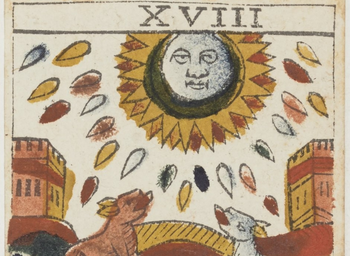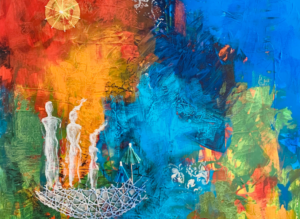Torah in the Tarot
Discovering Torah Stories in the original Tarot Cards
Published Mar 30, 2023

One day in 2018, data analyst Stav Appel’s wife brought home a deck of playing cards and said, “I thought you and the kids might enjoy playing with these on Shabbat.”
That was Stav’s entrée in tarot, an ancient card game with mystical roots that have long been thought to be in opposition of Jewish life.
Over many Shabbat games, Stav started to notice imagery in the cards that illuminated his Torah scholarship– symbols, numbers, and images that seemed to show the Torah stories Stav was discussing.
At first he thought it was a coincidence, but at the point he could tell the entire Exodus story through imagery on a playing card, he knew that what he had discovered likely wasn’t accidental.
This led Stav to an amazing theory that the Tarot De Marseilles, one of the earliest and most iconic decks of tarot cards, was created by crypto Jews seeking to retain their Jewish traditions following the Spanish inquisition.
Like many, your first question is like – is it true? While Stav has not been able to definitively confirm this theory, there’s no denying the layers of Jewish life and tradition that can be discovered within the deck.
History of the deck
1650 was one of the darkest moments in Jewish history. Jews were forbidden from living in England due to the Edict of Expulsion of 1290 declared by King Edward I. The exile of all Jews from France, declared by King Charles IV in 1394, continued unabated and forced the remnant of French Jewish life to become entirely covert. In Italy, by order of Papal decrees, Jews were living in ghettos, and required to wear hats and badges of public shame. Cossacks began to inflict a ruthless series of pogroms on Poland’s emerging Ashkenazi Jewish population. Many began to openly doubt the long-term survival of the Jewish people.
It was in this year that a French artist transformed the 22 picture cards of traditional Italian Tarot into a new set of enigmatic images with a secret purpose.
Secrets of the Tarot blends history, art, and cutting-edge visual technology in a unique presentation revealing the 400-year-old lost, forgotten, and secret Judaic origins of the world-famous Tarot de Marseille.
Torah in the Tarot is a project to share the hidden Jewish stories in the cards, along with an explanation of the Hebrew letters, Judaic ritual objects, Torah stories & Jewish holy days hidden in its images – all within the cards of the Tarot de Marseille, an icon of French cultural antiquity.
Stav took to social media to share his findings in 2023, and by 2024 had more than 22,000 followers.
In 2024, Stav began working with Ayin Press to publish a book of the cards. As he says,
“I wanted a publisher who could produce a new version of the deck that would be truly beautiful, to do proper justice to the genius of its original creators. I wanted to offer a deck that possesses the power of a genuine holy object. Thankfully the team at Ayin, working with the truly gifted artist Florent Giraud, has the technical expertise and aesthetic skills needed to fulfill this dream. And, finally, we decided to not only recreate the core 22 major arcana, the deck’s primary picture cards, but the entire 78 cards of the Tarot de Marseille, in an as historically accurate reproduction as possible.”
Before this theory, why was Tarot thought to be counter to Jewish tradition?
The school of Occult Tarot was arguably created by the French theorist Alphonse Louise Constant who published under the Hebrew pen name Eliphas Levi. In his book The Doctrine and Ritual of High Magic, published in 1856, Constant argued that the Tarot de Marseille contains a secret depiction of Kabbalah, and, more specifically, a form of Kabbalah that predates the existence of Judaism. He also argued that each of the 22 major arcana of the Tarot de Marseille represented a letter of the Hebrew AlphaBet. By associating the Tarot with Hebrew and Kabbalah, but not with Judaism, Constant gave birth to what would eventually be known as Occult Qabbalah and the Occult Tarot. I would also offer that his original interpretive invention effectively blinded generations of scholars to the cards’ veiled Judaic content.
In addition to being a beautiful narrative of Jewish life and traditions, Torah in the Tarot also tells an important story of how antisemitism has shaped Jewish practice and the world. As Stav says,
The Jewish world still resides in the shadow of the Holocaust which has had a distortive effect on our memory of the centuries of anti-semitism prior to the horrors of the 20th century. Most of us know that in 1492 the Jews of Spain were sent into exile, but very few know that the Catholic Church waged a centuries long campaign of destruction against Judaism across the entire Catholic world. I myself, a highly educated Jew by anyone’s standard, was entirely surprised to learn that in 1650 France, the location and approximate year of creation of the Jean Noblet Tarot, Judaism had been entirely illegal for over 250 years.
In the Noblet Tarot we can find a systematic concealment of Hebrew letters, Torah stories, Judaic ritual objects and Jewish holy days. The Judaic content is well hidden. We would make a terrible mistake in interpreting the veil of distortion placed over its Judaica as an artistic decision for theatrical effect. No, the card’s cryptography is evidence of desperation. The creators of the Noblet Tarot openly questioned whether Judaism would survive the trials of their time.
Reflections
I Spy...
Can you find the 3 matzot in the card?
A Secret History
How much did you know about Tarot before now? Did you ever see it as "Jewish"? Why or why not?
Want more?
Get curated JewishArts.org content in your inbox


